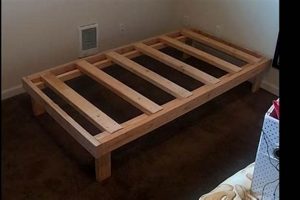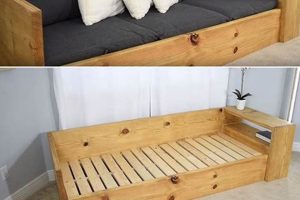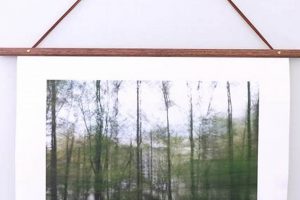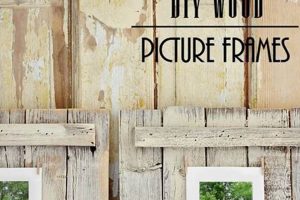A custom-built surround designed to enhance the aesthetic integration of a specific television model exemplifies the core concept. This process involves constructing a housing, often from materials like wood or metal, tailored to fit around the Samsung Frame TV, mimicking the appearance of a traditional picture frame. An example is building a wooden structure with mitered corners that attaches to the television using magnets or adhesive strips.
The creation of such enclosures offers a cost-effective alternative to commercially available options, allowing for personalization to match existing dcor and the expression of individual style. This approach gains significance given the television’s intended purpose to blend seamlessly into living spaces. Historically, individuals have sought ways to customize and personalize technology, integrating it more harmoniously into their homes.
The subsequent sections will delve into materials selection, construction techniques, and mounting considerations for building such a customized surround, providing a practical guide for achieving a professional and visually appealing result.
Tips for Constructing a Custom Television Surround
The following recommendations offer guidance in crafting a surround for a Samsung Frame TV, aiming for a professional finish and long-term durability.
Tip 1: Precise Measurement is Critical: Accurate dimensions of the television are paramount. Account for any necessary clearances for ventilation and cable management. Use precise measuring tools and double-check all measurements before cutting materials.
Tip 2: Material Selection Impacts Aesthetics and Durability: Choose materials that complement the existing decor and offer the desired level of robustness. Solid hardwoods offer superior longevity, while MDF provides a cost-effective and paintable surface. Consider weight limitations if mounting the television to a wall.
Tip 3: Joinery Techniques Enhance Structural Integrity: Employ appropriate joinery methods for the chosen material. Mitered corners secured with biscuits or splines provide a clean and professional appearance. Pocket hole joinery offers a simpler alternative, though the resulting holes should be concealed.
Tip 4: Finishing Details Elevate the Final Product: Apply a high-quality finish that protects the material and enhances its aesthetic appeal. Multiple coats of paint or stain, properly sanded between applications, will yield a smooth and durable surface. Consider a clear coat for added protection.
Tip 5: Secure Mounting is Essential for Safety: Utilize a secure mounting system that accounts for the weight of the television and the added surround. Magnets, adhesive strips, or custom brackets can be employed. Ensure the mounting system is compatible with the television’s VESA mount and the wall structure.
Tip 6: Cable Management Maintains a Clean Appearance: Plan for cable management during the construction process. Incorporate channels or openings within the surround to conceal cables and maintain a tidy appearance. Consider using cable ties or sleeves to bundle and organize cables behind the television.
Tip 7: Ventilation Prevents Overheating: Ensure adequate ventilation to prevent the television from overheating. Incorporate ventilation slots or gaps within the surround to allow for airflow. Avoid blocking any existing ventilation ports on the television itself.
Adhering to these recommendations contributes to a structurally sound, aesthetically pleasing, and safely mounted custom television surround.
The subsequent sections will address potential challenges encountered during construction and offer troubleshooting advice.
1. Material Selection
Material selection is a foundational determinant in the overall success of a self-constructed surround for a Samsung Frame TV. The choice directly influences the aesthetic integration, structural integrity, and long-term durability of the finished product. Using inexpensive materials such as lightweight pine may result in an unappealing aesthetic that detracts from the television’s intended purpose of mimicking a work of art. Conversely, selecting a hardwood like walnut or cherry necessitates greater woodworking skill and potentially higher costs but results in a visually superior and more robust surround. The selected material also impacts the ease of construction. MDF, for example, is relatively easy to cut and paint, but is susceptible to moisture damage. Therefore, the decision must balance aesthetic goals, budget constraints, and technical capabilities.
Considerations extend beyond the material’s visual appeal and workability. The chosen material’s weight is a critical factor, particularly when mounting the television and surround. Excessive weight can strain the mounting hardware, potentially leading to structural failure or damage to the wall. Additionally, the material’s thermal properties play a role. Darker materials absorb more heat, which, though generally negligible, could contribute to elevated operating temperatures within the television’s enclosure. Furthermore, the material’s compatibility with various finishing techniques, such as staining, painting, or varnishing, must be considered to achieve the desired aesthetic outcome.
In summary, appropriate material selection for a DIY television surround is not merely a cosmetic choice but a multifaceted decision with far-reaching consequences. Careful consideration of aesthetic goals, structural requirements, weight limitations, thermal properties, and finishing compatibility is essential for achieving a successful and lasting result. The material serves as the backbone of the project, influencing its appearance, durability, and overall functionality.
2. Joint Construction
Joint construction directly affects the structural integrity and aesthetic quality of a surround for a Samsung Frame TV. The manner in which individual pieces of the surround are joined dictates its ability to withstand stress, resist warping, and maintain a visually pleasing appearance. Inadequate joint construction can lead to visible gaps, structural instability, and ultimately, a diminished aesthetic, undermining the television’s intended purpose of seamlessly blending into the environment. For instance, a poorly executed miter joint in a corner could result in an unsightly gap, drawing attention away from the displayed artwork or photograph.
The choice of joint construction method depends on several factors, including the type of material used, the available tools, and the desired aesthetic. Miter joints, which involve angled cuts that meet at a corner, are often favored for their clean, seamless appearance. However, they require precision cutting and a strong adhesive or mechanical fastener to ensure a robust bond. Lap joints, where one piece of material overlaps another, offer greater strength and are relatively easy to execute, but they may not be as visually appealing for a high-end surround. Pocket hole joinery provides a concealed fastening method, but may not be suitable for heavy-duty applications. The appropriate joint selection is therefore crucial for the longevity and visual appeal of the surround.
Ultimately, proper joint construction is indispensable for a successful surround. It influences both the structural soundness and visual appeal, playing a critical role in achieving the desired aesthetic of a television that resembles a work of art. Neglecting this aspect can lead to a subpar finished product that detracts from, rather than enhances, the viewing experience. Attention to detail in selecting and executing appropriate joinery techniques is therefore paramount.
3. Finishing Technique
Finishing technique significantly influences the aesthetic integration and perceived quality of a surround constructed for a Samsung Frame TV. The application of paint, stain, or other surface treatments determines the final appearance of the surround, directly affecting its ability to either seamlessly blend into the surrounding decor or become a visually discordant element. A poorly executed finish, characterized by drips, uneven coverage, or an inappropriate color choice, can detract from the television’s intended purpose of mimicking a framed piece of art. Conversely, a well-executed finish, employing techniques such as sanding, priming, and multiple coats of paint or varnish, enhances the overall appearance and contributes to a sense of quality and craftsmanship.
The choice of finishing technique is intrinsically linked to the selected material. For example, hardwoods often benefit from staining to accentuate their natural grain patterns, followed by a clear topcoat for protection. MDF, on the other hand, typically requires priming and painting to achieve a smooth and uniform surface. Applying the incorrect finishing technique to a particular material can result in undesirable outcomes, such as poor adhesion, bubbling, or an uneven finish. Furthermore, the finishing technique can influence the durability of the surround. A protective topcoat, such as polyurethane, can shield the material from scratches, moisture, and UV damage, extending its lifespan. Consider, for example, a scenario where a surround constructed from pine is left unfinished. Over time, it may become discolored, scratched, and susceptible to warping, negating the aesthetic benefits of the television itself.
In summary, the finishing technique is an essential component in the creation of a custom surround. It directly affects the aesthetic integration, durability, and perceived quality of the final product. A well-considered and expertly executed finishing technique is crucial for achieving a surround that seamlessly complements the Samsung Frame TV and enhances its intended purpose as a visually appealing element within a living space. Understanding the interplay between material selection and finishing technique is therefore paramount.
4. Mounting Security
Mounting security is an indispensable component of any do-it-yourself surround for a Samsung Frame TV. The structural integrity of the installation hinges on the secure attachment of both the television to the wall and the surround to the television. Insufficient mounting practices can lead to catastrophic failures, resulting in damage to the television, the surround, and potentially causing injury. A real-world example involves a surround constructed from heavy hardwood, inadequately secured to the wall, ultimately detaching and causing significant damage to both the television and the surrounding area. The practical significance of this understanding cannot be overstated; safety and longevity are paramount.
Effective mounting necessitates a thorough evaluation of several factors. These include the weight of the television and the added weight of the surround, the structural capabilities of the wall, and the compatibility of the mounting hardware with both the television’s VESA mount and the wall’s construction. The selection of appropriate mounting hardware, such as wall anchors or heavy-duty brackets, is crucial. Furthermore, proper installation techniques, including precise measurements and secure fastening, are essential. An unstable mount can also impact the leveling of the unit, further affecting aesthetics.
In conclusion, mounting security is not merely an afterthought, but a critical design consideration for a homemade television surround. The interplay between material weight, wall structure, and mounting hardware dictates the long-term stability and safety of the installation. Neglecting this crucial aspect can lead to costly damages and potential hazards, underscoring the importance of prioritizing robust and secure mounting practices. The DIY endeavor demands strict adherence to safety protocols to ensure both aesthetics and functional longevity.
5. Cable Management
Effective cable management is an integral component of a self-constructed surround for a Samsung Frame TV. The absence of proper cable management directly undermines the aesthetic objective of the television, which is to resemble a framed work of art. Visible cables detract from the clean, minimalist appearance, transforming the installation into a visually cluttered element. A practical example involves a meticulously crafted wooden surround, marred by dangling power cords and HDMI cables, thereby negating the effort invested in the surround’s construction. The practical significance of this understanding lies in preserving the intended visual illusion.
Strategic cable management can be achieved through various methods. These methods include incorporating channels or conduits within the surround’s structure to conceal cables, utilizing cable ties or sleeves to bundle and organize cables behind the television, and carefully routing cables to minimize their visibility. Custom-designed cutouts within the surround can provide access for cables while maintaining a clean aesthetic. For instance, creating a recessed channel behind the television allows cables to be neatly routed to an outlet or media center, completely hidden from view. Careful planning during the surround’s design phase is crucial for implementing effective cable management solutions.
In conclusion, cable management is not a superficial detail but a vital element in achieving a successful integration of a Samsung Frame TV within a living space. The combination of careful planning, strategic implementation, and the appropriate use of cable management accessories is essential for maintaining a clean, uncluttered appearance and preserving the television’s intended aesthetic. Overlooking this aspect diminishes the impact of the DIY surround and compromises the overall visual effect.
6. Ventilation Design
Ventilation design constitutes a critical, often overlooked, aspect of constructing a surround for a Samsung Frame TV. The operational efficacy and longevity of the television are directly contingent upon adequate heat dissipation. Enclosing the television within a surround, particularly one constructed from insulating materials like wood or MDF, inherently restricts airflow and can lead to elevated operating temperatures. Elevated temperatures can, in turn, degrade performance, shorten the lifespan of electronic components, and, in extreme cases, trigger thermal shutdown mechanisms. For example, a surround constructed without ventilation provisions, especially one that tightly encases the television, can cause the internal temperature to rise significantly during extended use, leading to premature failure of the display panel or other critical components. This exemplifies the cause-and-effect relationship between inadequate ventilation design and potential hardware damage.
Effective ventilation design involves incorporating strategically placed vents or openings within the surround to facilitate airflow. The placement and size of these vents should be carefully considered to ensure optimal heat dissipation without compromising the aesthetic integration of the television. The vent design should also minimize the ingress of dust and other particulate matter, which can further impede airflow and contribute to overheating. Implementing a passive ventilation system, which relies on natural convection to circulate air, is a common approach. Alternatively, an active ventilation system, incorporating small, low-noise fans, can provide more effective cooling, particularly in situations where passive ventilation is insufficient. For instance, vents can be discreetly integrated into the back of the surround, aligned with existing ventilation ports on the television, to promote airflow without detracting from the overall appearance. The practical application of these principles ensures both aesthetic appeal and operational reliability.
In summary, ventilation design is not merely a cosmetic consideration but a fundamental engineering requirement for any surround built for a Samsung Frame TV. The absence of adequate ventilation can lead to performance degradation, component failure, and a shortened lifespan. By carefully considering the principles of heat transfer and incorporating appropriate ventilation strategies, it is possible to construct a visually appealing surround that also ensures the long-term operational integrity of the television. The challenge lies in balancing aesthetic considerations with the practical necessity of effective heat dissipation, thereby ensuring a functional and visually pleasing end product. This balance is central to the successful construction of a self-made Frame TV surround.
Frequently Asked Questions
The following questions address common concerns and considerations regarding the construction of a customized surround for the Samsung Frame TV.
Question 1: What materials are best suited for constructing a frame?
Material selection depends on desired aesthetics, budget, and skill level. Hardwoods (e.g., walnut, cherry) offer superior aesthetics and durability but require advanced woodworking skills and greater expense. Medium-density fiberboard (MDF) presents a cost-effective and paintable alternative, though it is susceptible to moisture damage.
Question 2: How are the frame components typically joined together?
Common joinery methods include miter joints, lap joints, and pocket-hole joinery. Miter joints provide a seamless appearance but demand precise cuts and secure fastening. Lap joints offer greater strength but may not be as aesthetically pleasing. Pocket-hole joinery offers concealed fastening but may not be suitable for heavy-duty applications.
Question 3: What finishing techniques are recommended for a professional look?
Finishing techniques depend on the selected material. Hardwoods often benefit from staining to accentuate natural grain, followed by a protective clear coat. MDF typically requires priming and painting to achieve a smooth, uniform surface. Multiple coats, properly sanded between applications, yield the best results.
Question 4: How can the frame be securely mounted to the television and the wall?
Secure mounting requires careful consideration of weight distribution and wall structure. Heavy-duty brackets, wall anchors, or magnets can be employed. Ensure the mounting system is compatible with the television’s VESA mount and the wall’s construction. Distribute weight evenly to prevent stress on mounting points.
Question 5: How can cables be effectively managed to maintain a clean aesthetic?
Cable management involves incorporating channels or conduits within the frame to conceal cables, utilizing cable ties or sleeves to bundle and organize cables, and strategically routing cables to minimize visibility. Custom cutouts can provide access for cables while maintaining a clean appearance.
Question 6: What measures should be taken to ensure adequate ventilation for the television?
Adequate ventilation is essential to prevent overheating. Incorporate strategically placed vents or openings within the frame to facilitate airflow. The placement and size of these vents should be carefully considered to ensure optimal heat dissipation without compromising the aesthetic integration.
The key takeaways emphasize material selection, secure mounting, cable management, and ventilation design. Ignoring these elements compromises the overall quality and functionality.
The following sections will address potential challenges encountered during construction and offer troubleshooting advice.
Conclusion
The creation of a diy frame for samsung frame tv represents a multifaceted endeavor demanding careful consideration of material properties, construction techniques, and functional requirements. The success of this project hinges upon meticulous planning, precise execution, and a thorough understanding of the interplay between aesthetics and practical considerations. This exploration has highlighted the crucial role of material selection, joint construction, finishing techniques, mounting security, cable management, and ventilation design in achieving a visually appealing and functionally sound outcome.
The endeavor to construct a diy frame for samsung frame tv necessitates adherence to established principles of design and engineering, thereby ensuring both aesthetic integration and operational longevity. Future advancements in materials and construction methodologies may further refine the process, but the fundamental principles of careful planning and precise execution will remain paramount. The integration of technology into domestic environments mandates a commitment to quality craftsmanship and a dedication to achieving seamless aesthetic harmony.







